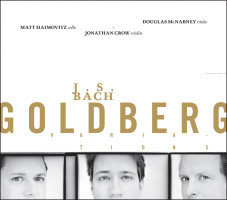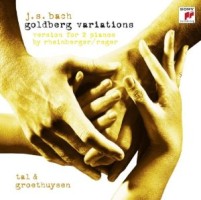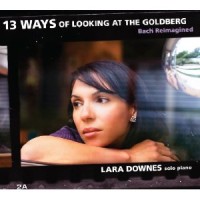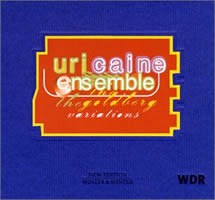(Dis)Arrangements 2: Goldberg Fever
|
Grant Chu Covell [December 2013.] A recent check disclosed 228 available recordings of Bach’s Goldberg Variations. Most are for a single keyboard as intended, but there are also arrangements and transcriptions. Here’s a random scattering of BWV 988 arrangements and digressions.
Johann Sebastian BACH: Goldberg Variations, BWV 988 (1741-42; arr. Catrin FINCH, 2008). Catrin Finch (harp). DG 00289 477 8165 (1 SACD, rec. March 2008, 63:50) (http://www.deutschegrammophon.com/). Johann Sebastian BACH: Goldberg Variations, BWV 988 (1741-42; arr. Kurt RODARMER, 1996). Kurt Rodarmer (guit). Sony SK 60257 (1 CD, rec. 1996, 73:36) (http://www.sonymasterworks.com/). Associations notwithstanding, the harp does tend toward purity. Harp and harpsichord share narrow timbral ranges; given this combination’s novelty and an audience’s scrutiny, Finch coaxes subtle color changes. The notes discuss difficulties: Chromatic music requiring fast pedaling and consistent resonance can be tricky given how long a harp string may vibrate until needing to be plucked again. Despite the virtuosity, I tire of the counterpoint’s homogeneity when I fail to detect linearity in the canons. I wouldn’t be surprised to hear this as background music in a shopping mall or greenhouse. Segovia student Rodarmer commissioned special guitars to encompass the required range. He plays two, three or four of them as needed to project lines and harmony. A well-considered reading, however far from revolutionary if this were a keyboard. Consistent voicing makes clear this isn’t an ensemble, but a single player with six hands. Rodarmer’s expressive vibrato on held notes is distracting.
Johann Sebastian BACH: Goldberg Variations, BWV 988 (1741-42; arr. Dmitri SITKOVETSKY, 1985). Julian Rachlin (vln), Nobuko Imai (vla), Mischa Maisky (vlc). Deutsche Grammophon 00289 477 6378 (1 CD, rec. February 2006, 80:08) (http://www.deutschegrammophon.com/). Johann Sebastian BACH: Goldberg Variations, BWV 988 (1741-42; arr. Dmitri SITKOVETSKY, 1985). Jonathan Crow (vln), Douglas McNabney (vla), Matt Haimovitz (vlc). Oxingale Records OX2014 (1 CD, rec. September 2007, 73:26) (http://www.oxingalerecords.com/). Johann Sebastian BACH: Goldberg Variations, BWV 988 (1741-42; arr. Dmitri SITKOVETSKY, 1985, rev. 1993). NES Chamber Orchestra. Nonesuch 79341-2 (1 CD, rec. October 1993, 59:40) (http://www.nonesuch.com/). Dedicated to Glenn Gould, Sitkovetsky’s trio arrangement puts violin front and center, inevitable when the original keyboard’s right-hand supplies so many high notes. A contrapuntal work like the Goldbergs should keep all voices equally active. Here the three strings sound frenzied and top-heavy. Presumably, Sitkovetsky took cues from Mozart’s WTC arrangements. I find the violin’s necessary vigor distracting and unidiomatic (a player confirmed that this particular arrangement is awkward). Among these performances the Crow-McNabney-Haimovitz group is especially strident. Rachlin-Imai-Maisky is more balanced, but the viola part still obscure. The five-part string orchestra with harpsichord (with Sitkovetsky leading the violins) is lively and the balance problems are largely improved. I crave the original withal.
Johann Sebastian BACH: Goldberg Variations, BWV 988 (1741-42; arr. Richard BOOTHBY, 2011). Fretwork: Susanna Pell, Asako Morikawa, Liam Byrne, Reiko Ichise, Richard Tunnicliffe, Richard Boothby (viols). Harmonia Mundi HMU 907560 (2 CDs, rec. March 2011, 43:33 + 46:42) (http://www.harmoniamundi.com/). Johann Sebastian BACH: Goldberg Variations, BWV 988 (1741-42; arr. Bernard LABADIE, 1999). Les Violons du Roy, Bernard Labadie (cond.). Dorian xCD-90281 (1 CD, rec. September 1999, 79:30) (http://www.dorian.com/). Fretwork offers a return to the clavenist’s drowsy aims, stretching BWV 988 longer than qualifies as leisurely. Should the Goldbergs become innocuous? Not to slight the viol sextet, but this rendition requires endurance in order to achieve the 90-minute mark. Everything is sensitively contoured, no notes are slighted. While I didn’t follow along, it feels as if all repeats are taken with pleasure. Bach would not have taken issue with arranging music to fit resources. However, in his day a colossal concerto grosso the instrumentation of which changes at every turn would have been unthinkable. In Labadie’s universe the keyboard original never existed. The variety encourages alertness, even if performing styles are incongruous. Is this period emulation or a gussied-up Romantic treatment? The single-voiced variations (such as the Aria) might emphasize ornaments, and tapered lines permit vibrato. Full-ensemble variations over percussive harpsichord and theorbo suggest Stokowski or Karajan’s grandstanding.
Johann Sebastian BACH: Goldberg Variations, BWV 988 (1741-42; arr. Arthur FRACKENPOHL, 1999). The Canadian Brass: Jens Lindemann, Ronald Romm (tpt), Christopher Cooper (hrn), Charles Daellenbach (tuba), Eugene Watts (euph). RCA 09026-63610-2 (1 CD, rec. June 1999, 50:42) (http://www.rcarecords.com/). The tonal brass quintet suggests a perky holiday season at odds with the music’s reputed soporific intent. Proclaimed with such constant articulation, the keyboard work becomes an endless rectangular grid. Owing to distinct timbres, canonic voices rarely match. The Canadian Brass is supremely agile; nevertheless, these lines are too busy and leaden. The Quodlibet is a nice change of venue, perhaps because the original tunes might have been played by brass. Otherwise, a fat Christmas goose.
* * *
Johann Sebastian BACH: Goldberg Variations, BWV 988 (1741-42; arr. Josef RHEINBERGER, 1883; arr. Max REGER, 1915). Yaara Tal, Andreas Groethuysen (pnos). Sony 88697526962 (1 CD, rec. April 2009, 76:06) (http://www.sonyclassical.de/). Rheinberger and Reger’s adventures belong to their period. Bach’s severity has been seasoned with crunchy herbs. Extra lines and counterpoints are mostly subtle, supplying doublings or emphasis. Now and again extra dissonances and fanciful verdigris appear. It’s much like coming across someone else’s copy of a book you know well, and wondering why certain passages, punctuation and spaces were marked with fluorescent highlighter. Tal and Groethuysen provide colorful shading and strong shape for this curiosity.
“13 Ways of Looking at the Goldberg.” Johann Sebastian BACH: Aria from the Goldberg Variations, BWV 988 (1741-42); Sarabande from French Suite No. 5, BWV 816. Fred LERDAHL: Chasing Goldberg. Jennifer HIGDON: The Gilmore Variation. Bright SHENG: Variation Fugato. Lukas FOSS: Goldmore Variation; Prelude in D. Derek BERMEL: Kontraphunktus. Fred HERSCH: Melancholy Minuet. C. CURTIS-SMITH: Rube Goldberg Variation. Stanley WALDEN: Fantasy Variation. Ryan BROWN: Ornament. Mischa ZUPKO: Ghost Variation. David DEL TREDICI: My Goldberg. William BOLCOM: Yet Another Goldberg Variation. Ralf GOTHÓNI: Variation on Variation with Variation. Dave BRUBECK: Chorale from Chromatic Fantasy Sonata. Lara Downes (pno). Tritone Records 0003 (1 CD, rec. June 2011, 60:57) (http://www.laradownes.com/). The roster interests more than the results. The Irving S. Gilmore International Keyboard Festival commissioned a clutch of post-Bach variations in 2004 for Gilbert Kalish and it appears that Downes provides the first recording. Except for the Lerdahl, I couldn’t find a way into these indistinguishable and monotonous essays. A single effective variation is actually tougher to craft than a string of several. The Bolcom and Gothóni did prompt one to see what was playing; otherwise not. There are a few add-ons, Brubeck’s long Chorale the worst offender.
Uri CAINE: The Goldberg Variations (2000). Uri Caine, et al. Winter and Winter 910 054-2 (2 CDs, rec. 1999-2000, 76:26 + 77:29) (http://www.winterandwinter.com/). This cast of thousands already came under scrutiny. I didn’t mind a return trip if only to see whether I disliked the same things – and was pretty quick with the fast-forward button. David Moss’ vocalizations still annoy. There’s something for everybody or, depending how you look at it, nothing for anyone. This 72-piece collection could be perfect background for a manic house cleaning.
Robin HOLLOWAY: Gilded Goldbergs for two pianos after J.S. Bach, Op. 86 (1992-97). The Micallef-Inanga Piano Duo: Jennifer Micallef, Glen Inanga (pnos). Hyperion CDA67360 (2 CDs, rec. June 2002, 46:24 + 51:50) (http://www.hyperion-records.co.uk/). Holloway has cleverly penciled learned and fanciful doodles over and around the Goldbergs. There are additional pages and enveloping footnotes. He’s pretty much rewritten and expanded the entire thing. The notes portray BWV 988 as a scaffold for Holloway’s “Music History 101,” an idiosyncratic exploration of keys, periods and styles, serious and fanciful. This is a players’ Goldbergs and Micallef and Inanga are formidable. And Bach is in here somewhere.
“Bachbusters: Music of J.S. Bach as realized on digital and other authentic period synthesizers.” Johann Sebastian BACH arr. Don DORSEY: Var. comps. Telarc CD-80123 (1 CD, rec. July – October 1985, 46:35) (http://www.telarc.com/). On my island W. Carlos’ Switched-On Bach is one of mankind’s greatest achievements. Dorsey evidently thinks so too. No Goldbergs here per se, just a version of the Canons, BWV 1087 derived from the Variations’ bass line. Other works include the Italian Concerto, BWV 971, several two- and three-part inventions (repeating a few Carlos had done), the famous D-minor Toccata and Fugue, BWV 565, and the perennial Jesu which endures the most liberties. Retrospect smiles upon the “authentic period synthesizers” in the title. Apparently these were multi-tracked recordings done before digital mixers, so the effort to layer keyboard and occasional percussion (!) must have been considerable. Heretical as it may seem, synthesized Bach succeeds because the lines are so clean. Well, the 14 Canons are perhaps goofier because they are short and permit exotic sounds.
Karlheinz ESSL: Gold.Berg.Werk. (2002-03) with Johann Sebastian BACH: Goldberg Variations, BWV 988 (1741-42; arr. Dmitri SITKOVETSKY, 1985). Christina Neubauer (vln), Martin Kraushofer (vla), Eva Landkammer (vlc), Karlheinz Essl (electronics). Preiser Records 90753 (1 enhanced CD, rec. March 2008, 63:12) (http://www.preiserrecords.at/). Essl speaks frankly of the perils surrounding combining live electronics with one of the literature’s greats. Encouraged by an insistent string trio, Essl capitulated. He created five electronic episodes from a string trio recording of the Aria and reorganized the trio’s variations into four groups, discarding those most linked to keyboards. It’s an agreeable gesture. In performance, the trio is visible whereas the electronics should come from afar, perhaps even heaven-sent as it apparently seemed at the premiere. Essl’s treatment follows the Aria’s metrical structure. Indeed, the entire assembly of strings alternating with electronics is based on the original’s 32-bars and subdivisions. There’s a tritone-rich electronic Fantasia Chromatica which Essl admits turned out something like Nono’s La Lontananza. After so much Goldberg listening, it relieves to hear the variations in a different order. And yet I wanted more electronics. The enhanced CD offers a 4:30 movie which interleaves strings and electronics within the Aria, a formation which doesn’t otherwise appear. Details can be found at Essl’s website.
* * *
Johann Sebastian BACH: Goldberg Variations, BWV 988 (1741-42)1; 14 Canons, BWV 10872; two songs “Die Wasserrüben und der Kohl” and “Ich bin so lang nicht bei dir gewest” found in Variation 303. Céline Frisch1,3 (hpsi), Dominique Visse3 (countertenor), Café Zimmermann2,3. Alpha 014 (2 CDs, rec. August 2000, November 2000 and March 2001, 77:30 + 24:50) (http://www.outhere-music.com/en/labels/alpha). When all’s said and done, my favorite version has the Goldbergs on a harpsichord, as written (another view here). For lagniappe, satisfying one’s taste for peculiar arrangements, a string sextet presents the 14 Canons and a varied ensemble with a countertenor fleshes out the two pop songs in the Quodlibet. There’s no doubt that some inventive detective work found matching texts for the tunes. The aptly named Café Zimmermann revels in the songs, improvising as they go. It doesn’t hurt that the cover reproduces the Haussman portrait of Bach.
Bach, Bermel, Bolcom, Caine, Curtis-Smith, Del Tredici, Essl, Foss, Gothoni, Hersch, Higdon, Holloway, Lerdahl, R Brown, Reger, Rheinberger, Sheng, Walden, Zupko
[More (Dis)Arrangements, Grant Chu Covell]
[More
Bach, Bermel, Bolcom, Caine, Curtis-Smith, Del Tredici, Essl, Foss, Gothoni, Hersch, Higdon, Holloway, Lerdahl, R Brown, Reger, Rheinberger, Sheng, Walden, Zupko]
[Previous Article:
Acoustic Revive’s RAF-48H Air-Floating Board]
[Next Article:
Piano Factory 11.]
|














